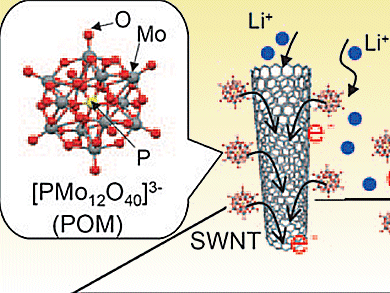Batteries with cathodes made of polynuclear metal clusters have the potential to achieve high capacities and fast charging/discharging due to multi-electron redox processes. Hirofumi Yoshikawa, Kunio Awaga, and colleagues, Nagoya University, Japan, have studied nanohybridization between a polyoxometalate (POM) cluster and single-walled nanotubes (SWNTs) as well as the battery performance of POM/SWNT hybrid materials.
They show that individual POM molecules are adsorbed onto the surfaces of SWNTs without chemical decomposition. The charging/discharging rate for a battery with a cathode of POM/SWNT hybrid material was twice that of those with a microcrystalline POM cathode. The POM/SWNT batteries also had higher capacity (>300 Ahkg–1). The improved performance is thought to be due to the nanohybrid structure promoting smooth electron transfer and lithium ion diffusion.
- Nanohybridization of Polyoxometalate Clusters and Single-Wall Carbon Nanotubes: Applications in Molecular Cluster Batteries
N. Kawasaki, H. Wang, R. Nakanishi, S. Hamanaka, R. Kitaura, H. Shinohara, T. Yokoyama, H. Yoshikawa, K. Awaga,
Angew. Chem. Int. Ed. 2011.
DOI: 10.1002/anie.201007264



